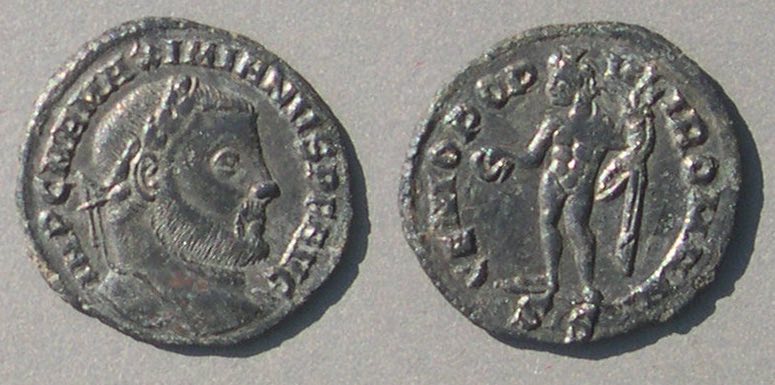 The unusual quarter-follis coin denomination of the Roman Empire, 305-306 AD.
The unusual quarter-follis coin denomination of the Roman Empire, 305-306 AD.
Coins of Maximian and the Second Tetrarchy: Galerius, Constantius I, Maximin II, and Severus II.
To the right: A 19 mm quarter-follis of Maximian (discussed below).
What's new? 2024, April 24: A better image for Constantius type 5.
2022, Sept. 30: A unique quarter-follis from Serdica.
In AD 305-306, just as the first tetrarchy was ending and the second beginning, the Roman mint of Siscia (now Sisak in modern Croatia at the red marker) struck an AE type of unusual denomination for the Roman emperors Maximian, Constantius, and Galerius as Augusti and Severus II and Maximius II as Caesars. 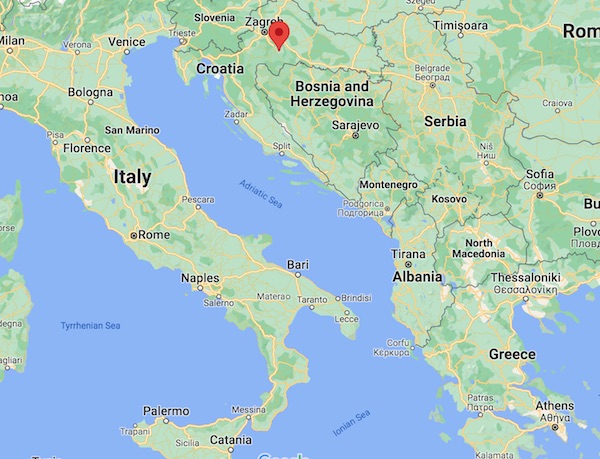 We don't know what the denomination was called then, but in modern literature it is often termed the "quarter follis" or "denarius." Although there were sixteen mints in the Roman empire striking coins at the time, only Siscia minted this small denomination (with one exception), and only for a very short time. The new denomination was only 19 mm, small compared to the usual denomination at the time which was the large (26-28 mm) "nummus" which, for many years, has been called by collectors a "follis" (although now we have learned from Crawford the proper term is "nummus," but the newer term is not catching on). Here are their relative sizes:
We don't know what the denomination was called then, but in modern literature it is often termed the "quarter follis" or "denarius." Although there were sixteen mints in the Roman empire striking coins at the time, only Siscia minted this small denomination (with one exception), and only for a very short time. The new denomination was only 19 mm, small compared to the usual denomination at the time which was the large (26-28 mm) "nummus" which, for many years, has been called by collectors a "follis" (although now we have learned from Crawford the proper term is "nummus," but the newer term is not catching on). Here are their relative sizes:
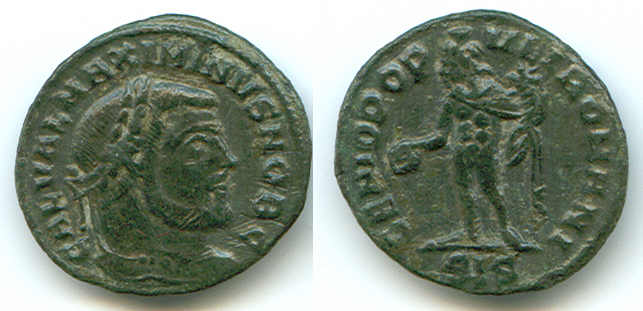

[Click on images to increase their size]
The "quarter follis," left, compared to the usual follis (nummus), right. Two coins of Maximinus II, as Caesar, AD 306. The smaller coin is 19 mm, while the larger is 27 mm. All quarter folles are from Siscia, with mintmark SIS. This follis is from Trier (Treveri), with mintmark PTR.
All have a very common reverse type: Genius standing left holding out patera (a shallow sacrificial bowl) in his right hand and holding a cornucopia in his left, with reverse legend GENIO POPVLI ROMANI, "Genius (spirit) of the Roman People".
The standard reference work for the period is RIC VI (Roman Imperial Coinage). On pages 471 and 475 RIC lists ten varieties among 5 emperors, differing only on the obverse, with various obverse legends, listed next. "Failmezger" refers to Roman Bronze Coins by Victor "Tory" Failmezger, 2002. (Although, see below for a puzzling unlisted piece.)
ID# |
Emperor |
Obverse Legend |
RIC Siscia# (for updated
rarities, see here)
Failmezger #
weight and
die axis of this piece |
Image
(Click the image to make it larger) |
| 1 |
Maximian |
IMP C M A MAXIMIANVS PF AVG |
146, "R3"
(RIC rarities are out of date. See here for up-to-date relative frequencies)
plate IX
Failmezger 29
2.25 grams
6:00 |
 |
| 2 |
Maximian |
IMP C M A MAXIMIANVS AVG |
147, "R3"
Failmezger 59
2.87 grams
6:00 |
 |
| 3 |
Constantius I |
IMP C CONSTANTIVS PF AVG |
167, "R"
Failmezger 59
1.76 grams
6:00 |
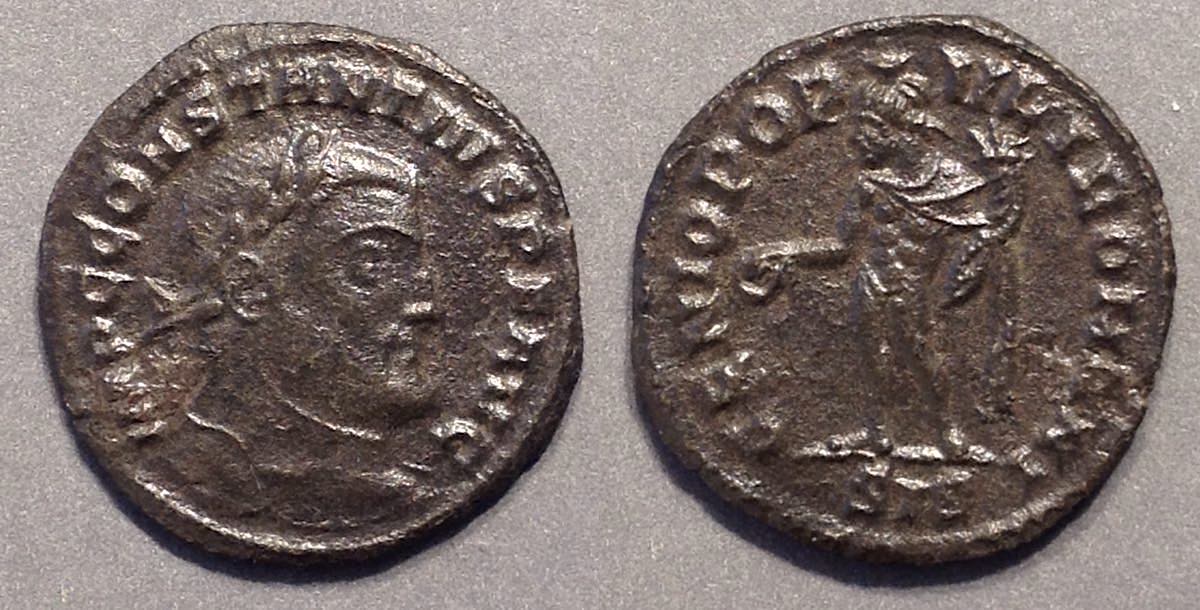 |
| 4 |
Constantius I |
IMP CONSTANTIVS PF AVG |
168, "R2"
Failmezger 59 |
no image
Does this type really exist with this obverse legend?
I doubt it. A friend and I have been looking for a published
example, or one offered in the trade, and have not found
evidence for it, other than the RIC citation to an example
in Vienna. Dr. Gunther Dembski of the Coin Cabinet in
Vienna has confirmed they do not have this variety.
Therefore, I think the RIC example was misrecorded and does not exist. However, if you have one, or a citation to one, please let me know. |
| 5 |
Constantius I |
CONSTANTIVS AVG |
169a, "R2"
Failmezger 59
1.76 grams
5:30 |
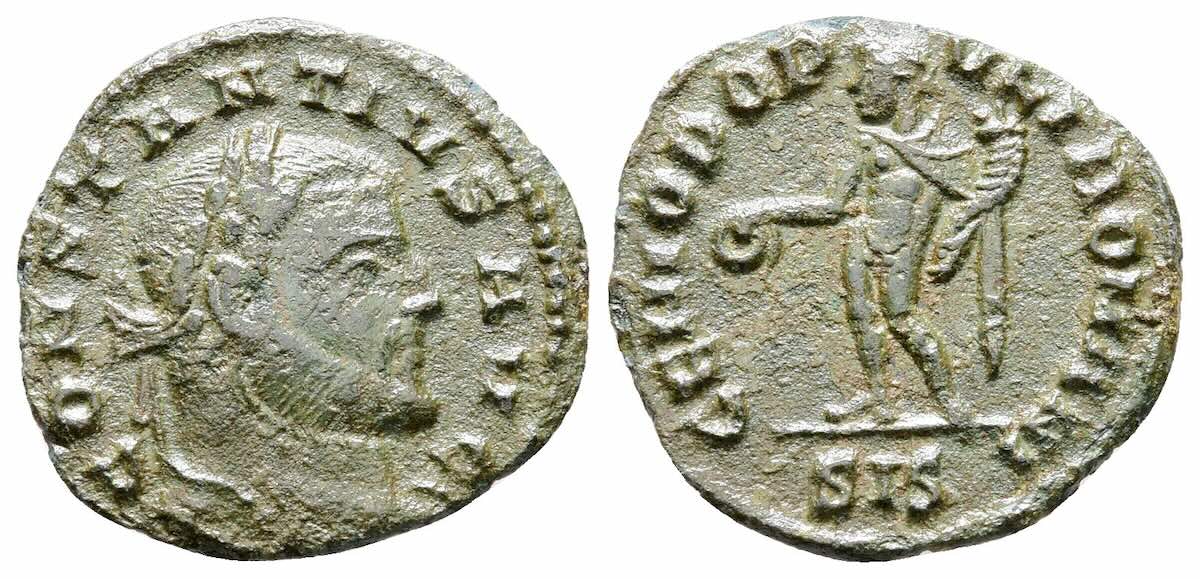 |
| 6 |
Galerius
(Don't let the legend fool you!) |
MAXIMIANVS AVG |
169b, "R2"
Failmezger 59
2.29 grams
6:00 |
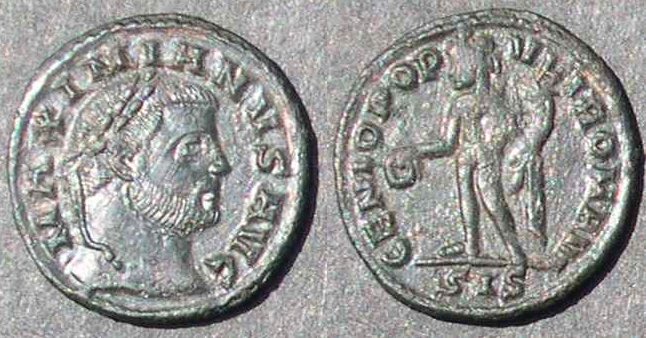 |
| 7 |
Severus II |
FL VAL SEVERVS NOB C |
170a, "R"
Failmezger 59
2.00 grams
12:00 |
 |
| 8 |
Severus II |
SEVERVS NOB C |
171a, "R"
plate IX
Failmezger 59
2.88 grams
12:00 |
 |
| 9 |
Maximin II |
GAL VAL MAXIMINVS NOB C |
170b, "R"
Failmezger 59
2.17 grams
12:00 |
 |
| 10 |
Maximin II |
MAXIMINVS NOB C |
171b, "R"
Failmezger 59
2.06 grams
6:00 |
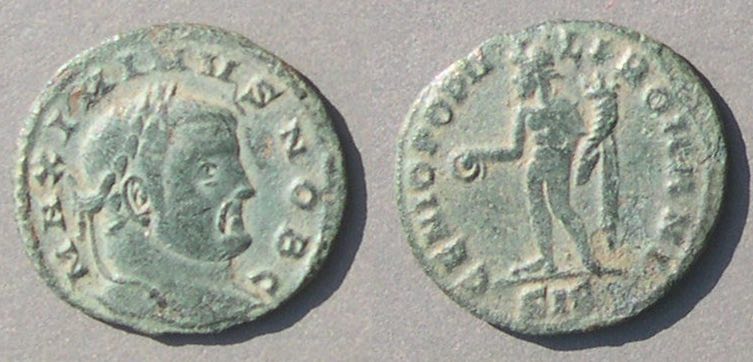 |
(Here is a page of frequencies of the various types in two major collections.)
RIC notes: Types 1 and 2 are dated as "c. 305 (?)" and the weights are given as "2.3-1.5 gm". On page 471, note 1 comments on types 1 and 2: "These very rare coins [but not anymore, RIC was written 50 years ago], known so far for Herculius [Maximian] only, show a portrait which is not truly Herculian, though it is certainly not truly Galerian either. Voetter (N. Z. 1920, p. 104 and VG., p. 290, on no. 4) called attention to the inaccuracy of Siscian engravers and argued that this issue, if really struck for Herculius, should have included coins for his colleagues in power. In view of the essential rarity of the coins in Herculius' name this argument is not in itself convincing, and accordingly they have been placed in Group 1 [i.e. before the second tetrarchy]; conceivably they were struck at the moment of adbication. It is right, however, to draw attention to the fact that similar coins-- not without some problems of their own-- were being produced in Group II [i.e. during the second tetrarchy, types 3-10 above]."
Types 3 through 10 are dated "305-6" with reverse axis 12:00 or 6:00 and weights "2.3 - 1.5 gm."
Failmezger illustrates types 1, 7, and 10. Failmezger's types refer to reverse types in various time periods. Several rulers may have the same Failmezger type number if they issued coins with the same reverse.
The First Tetrarchy: 293-305: Diocletian (eastern) and Maximian (western) Augusti,
Galerius (eastern) and Constantius I (western) their Caesars.
The Second Tetrarchy: Just after 305: Constantius I (western) and Galerius (eastern) Augusti,
Severus II (western) and Maximin II (eastern) their Caesars.
Important dates: Diocletian and Maximian abdicated May 1, 305 and Galerius and Constantius I became Augusti on that date. Constantius I died July 25, 306, because of which Severus II was promoted from Casear to Augustus. Therefore, the imperial titles on the coins show they must have been minted before the elevation of Severus became known at Siscia, and could not have begun much before May 1, 305.
Controversy. How can these five rulers, and only these five, be on a single issue? The legends of the last four emperors in the table fit with the period of the second tetrarchy, but the first one appears to be of Maximian and he was supposedly forceably retired at the same time as the other four were elevated. Can we argue that this issue was barely begun for Maximian (and then, why not Diocletian too?) and then continued for the new rulers? Without a better explanation at hand, this is the arrangement used by RIC in 1973.
Here are some relevant points.
Coins of Maximian and Galerius can be difficult to distinguish. Modern numismatists use these two very distinct names to distinguish these two, but their full names used in ancient times on were very similar.
Maximian was: Marcus Aurelius Valerius Maximianus
Galerius was: Caius Galerius Valerius Maximianus
Maximian was never Caesar, only Augustus, so coins with "MAXIMIANVS" and the title Caesar belong to Galerius. Also, coins with "GAL VAL MAXIMIANVS" belong to Galerius. (Be careful, coins with "GAL VAL MAXIMINVS" belong to Maximin II.) However, when Galerius became Augustus in 305 he sometimes used "IMP MAXIMIANVS PF AVG," a legend also associated with Maximian.
The RIC footnote quoted above makes reference to the portrait, which lacks the upturned nose often seen on portraits of Maximian from other mints (see the next images below). However, for type 1, the "M A" is conclusive -- it must be Maximian. So, it was issued for Maximian without being issued for Diocletian. But, was it issued before the second tetrarchy, or during it? Diocletian was the one who decided that he and Maximian should abdicate. At some mints they continued to be represented with abdication types and the status of "senior" emperors (shown on coin legends with "S AVG" or even "SEN AVG" where "AVG" had been). Maximian was opposed to retiring and was an unwilling participant in his own adbication. The complicated story of the years 305-310 and their numerous rulers was told (by me) in the September 1997 issue of the Celator (and reproduced here). The relevant part is that Maximian continued to consider himself Augustus. Did he somehow influence the Siscia mint to mint with him as Augustus-- an influence that lasted only a very short while before his types, and the denomination as a whole, were discontinued? According to RIC (p. 436) Siscia "was the eastern most of the mints in the administrative area assigned to Heraclius [Maximian]." Perhaps it is not unlikely that Sisica would continue to mint for Maximian in accordance with his wishes, at least for a short time. However, the question of why this denomination was created at all, and why only at Siscia, remains totally unaddressed.
After I first posted this page I received an image of this coin, courtesy of Mihail Arandarenko, who recognized its interest.
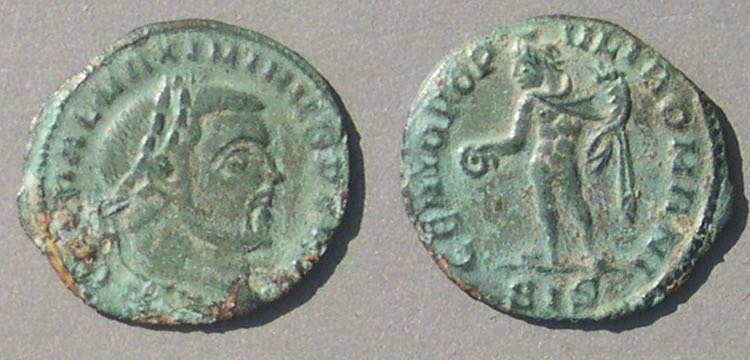 Probably a Maximinus II as Caesar with an engraver's error.
Probably a Maximinus II as Caesar with an engraver's error.
Study the legend closely. It is
GAL VAL MAXIMINVS PF AVG
which is either an engraver's error or from Maximin II as Augustus!
It could be a Galerius, missing the "A" of MAXIMIANVS
or it could have "PF AVG" for "NOB C" by mistake. However, Siscia did not use "GAL VAL" for Galerius as Augustus on this or any of the other denominations, so the explanation of the abberant legend is not as simple as saying that only one letter was missing from an attested Galerius legend. On the other hand, each of the other rulers has at least two varieties of legend and Galerius does not. Why not? Maybe this is his second variety, misspelled on this example.
The second possibility of a title error is not too far-fetched. Perhaps the celator had recently been making dies for an Augustus and forgot to switch titles to Caesar when he switched to making dies for Maximin II.
One other possibility is that the type really did continue until Maximin II was Augustus (November 308). The denomination certainly is common today in the region where it was minted, which suggests a longer period of minting than RIC's rarity ratings suggest. However, that would leave the absence of his co-rulers unexplained. (See my article in the September 1997 issue of the Celator for the complicated sequence of events and titles of the period. It is also on the web here). A similar piece in Vienna with this legend is reported in RIC page 475, note 1, in which Sutherland writes, "An engraver's error; no resumption of this reverse type can be conceived of after Maximinus' elevation."
Mihail and I have decided it is probably a Maximinus II with "PF AVG" engraved in error for he usual "NOB C". The attribution is based on the portrait. The beard is trimmed around the jaw line as seen on other coins certainly of Maximinus II (types 9 and 10 above) and, in contast, coins of Galerius (type 6) show a fuller beard.
A unique coin from Serdica.
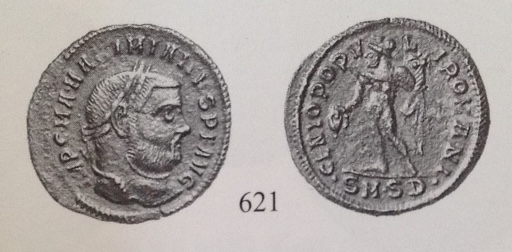 Maximian
Maximian
IMP C MA MAXIMIANVS PF AVG
Mintmark: •SM•SD•
This coin was in Jacquier 32 (Summer 2004) lot 621. They called it unpublished and unique.
Remarkable! This is the only example I have seen which is not from Siscia.
Rarity. RIC was published in 1973. After the Iron Curtain came down in the 1990s, a flood of coins from the region of Siscia commenced and has not let up. The rarities of coins from that region have changed dramatically. These types, formerly "very rare" or "rare" (as listed in the table above) have mostly become only "rare" or "scarce" or even almost common, athough there are, still today, dozens of GENIO POPVLI ROMANI folles for every quarter follis.
Mihail has classified over two hundered of these coins by variety. The data (from April 2010) is here.
Other than RIC, two of the best-illustrated references for Roman AE of this period are the Hunter Catalog, volume 5 (which is expensive), and the Spanish price guide, Compendio de las Monedas del Imperial Romano, volume III (1985), by Cayon (which is very rarely offered). Hunter has none of these at all, and, although they are listed in Cayon and many types in Cayon are illustrated with numerous pieces, only one piece (Type 7 of Severus II) of this series is illustrated. These facts demonstrate the rarity of these coins prior to 1990.
Here are some comparisons with the full-sized denomination.
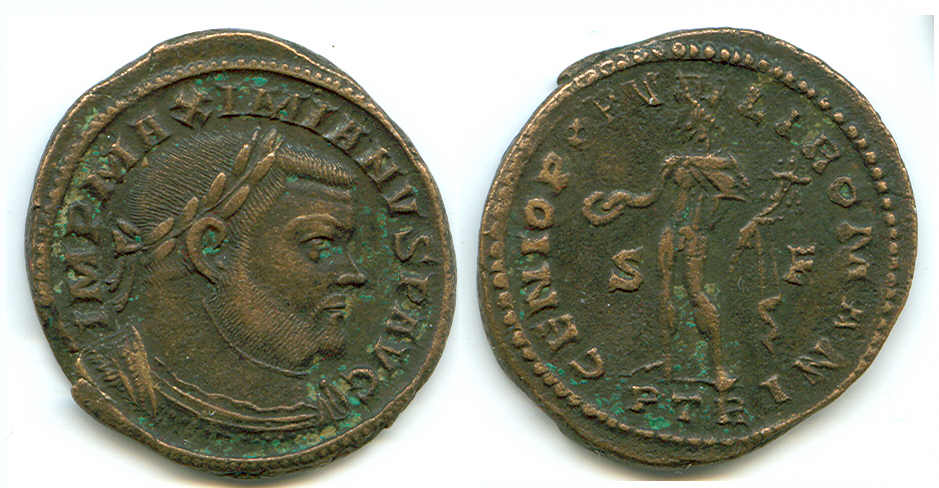

Maximian on a follis and quarter follis. Note the slight upturn to the nose on the follis. This is very unusual among Roman rulers, and can serve to identify Maximian on coins. The nose on the quarter-follis is not clearly that upturned nose, but it is also not certain that it is not. This is the ambiguity that the footnote quoted above refers to. On the other hand, a glance down the column of obverses in the table shows that the portraits were not very distinguishable anyway. Here are some images of these rulers from other mints.
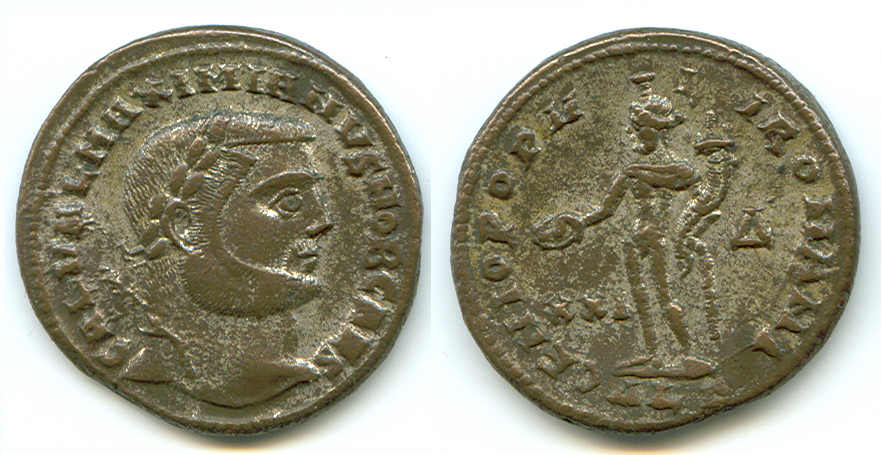
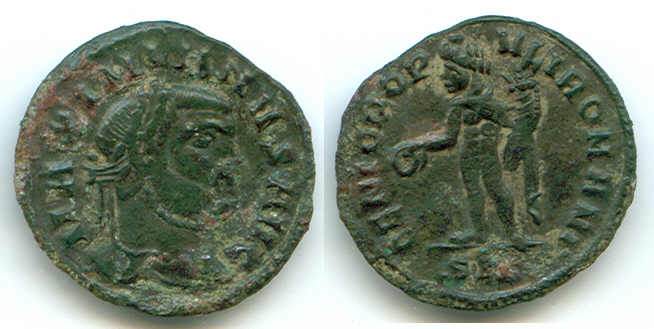
Galerius, mint of Alexandria (ALE) and one of his quarter folles.

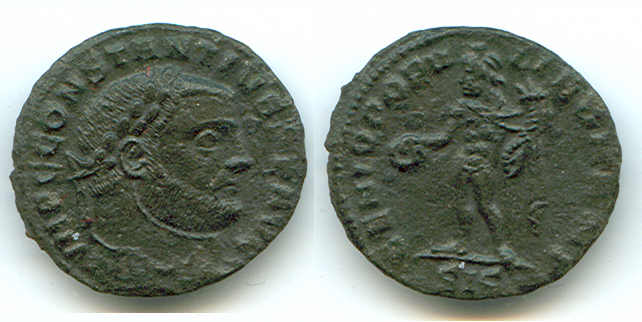
Constantius I, mint of Heraclea (HTS), and one of his quarter folles.
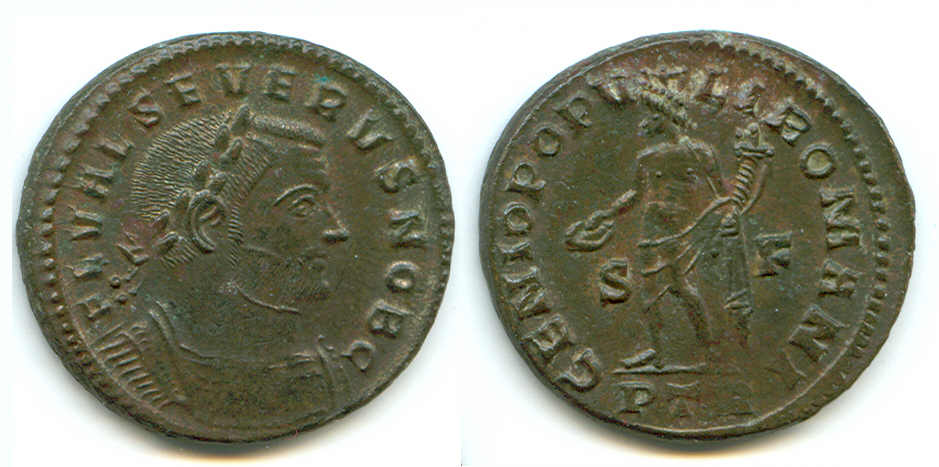
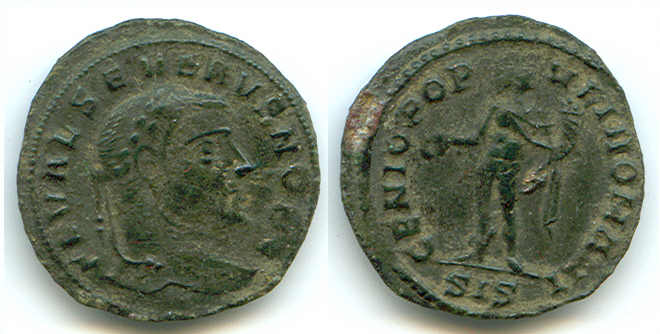
Severus II, mint of Trier (PTR), and one of his quarter folles.


Maximin II, mint of Trier (PTR), and one of his quarter folles.
If you care about this series, you may write me at 
This page posted 7/12/2005. Revised 7/14. Revised 7/27. Revised May 23, 2010. Maintained 3/16/2015. Revised 5/29/2016. Revised 2/6/2020. Frequency table revised Sept. 25, 2021. Serdica coin added, 2022, Sept. 30.
Go to the main page on Ancient Roman and Greek Coins.
 The unusual quarter-follis coin denomination of the Roman Empire, 305-306 AD.
The unusual quarter-follis coin denomination of the Roman Empire, 305-306 AD.  We don't know what the denomination was called then, but in modern literature it is often termed the "quarter follis" or "denarius." Although there were sixteen mints in the Roman empire striking coins at the time, only Siscia minted this small denomination (with
We don't know what the denomination was called then, but in modern literature it is often termed the "quarter follis" or "denarius." Although there were sixteen mints in the Roman empire striking coins at the time, only Siscia minted this small denomination (with 









 Probably a Maximinus II as Caesar with an engraver's error.
Probably a Maximinus II as Caesar with an engraver's error. Maximian
Maximian







